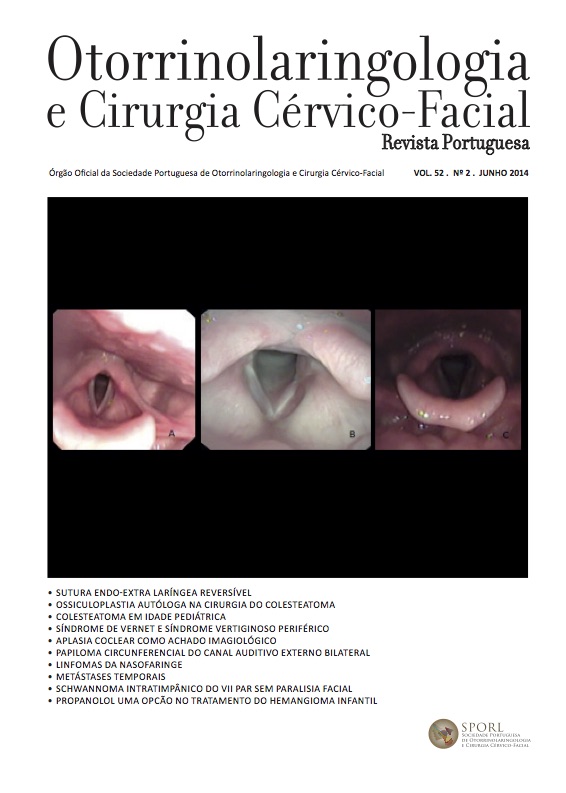Pediatric cholesteatoma: 12-year retrospective analysis of Hospital Prof. Doutor Fernando Fonseca´s experience
DOI:
https://doi.org/10.34631/sporl.459Keywords:
pediatric cholesteatoma, mastoidectomy, cholesteatoma treatmentAbstract
Objective: To review cases of cholesteatoma in pediatric age HFF during a period of 12 years.
Study design: Retrospective review.
Material and methods: Analysis of 30 cases of children undergoing surgical intervention for cholesteatoma from January 2000 to December 2011.
Results: At presentation, cholesteatoma was extensive in most cases. These children were managed with open technique mastoidectomy (66.7%), closed technique mastoidectomy (26.7%), transmeatal atticotomy (3.3%) and cholesteatoma removal from tympanic membrane (3.3%). The mean postoperative air-bone GAP was 22.5 dB. Postoperative air-bone GAP distributed as follows: 16,7% of children had 0-10dB GAP, 10% of chlidren had a 11-20dB GAP, 30% of children had a GAP 21-30 dB in 30%, and 16.7% had a more than 30 dB GAP. The auditory results were unknown in 26.7% of cases. The recurrence rate of cholesteatoma was 23.3%
Conclusions: In our study, cholesteatoma was extensive and aggressive. Most children were managed with open technique. For good results the approach should be individualized, taking into account clinical, anatomical and social factors.
Downloads
References
Soldati D, Mudry A. Cholesteatoma in children: techniques and results. Int J Pediatr Otorhinolaryngol. 2000 May30;52(3):269-76.
Schraff SA, Strasnick B. Pediatric cholesteatoma: A retrospective review. Int J Pediatr Otorhinolaryngol. 2006 Mar;70(3):385-93.
Goçmen H, Kilic R, Ozdek A, Kizilkaya Z, et al. Surgical treatment of cholesteatoma in children. Int J Pediatr Otorhinolaryngol. 2003 Aug;67(8):867-72.
Silvola J, Palva T. One-stage revision surgery for pediatric cholesteatoma: long term results and comparison with primary surgery. Int J Pediatr
Otorhinolaryngol. 2000 Dec 1;56(2):135-9.
Ueda H, Nakashima T, Nakata S. Surgical strategy for cholesteatoma in children. Auris Nasus Larynx. 2001 Apr;28(2):125-9.
Nevoux J, Lenoir M, Roger G, Denoyelle F, et al. Childhood cholesteatoma. Eur Ann Otorhinolaryngol Head Neck Dis. 2010 Sep;127(4):143-50.
Ahn SH, Oh SH, Chang SO, Kim CS. Prognostic factors of recidivism in pediatric cholesteatoma surgery. Int J Pediatr Otorhinolaryngol. 2003
Dec;67(12):1325-30.
Mishiro Y, Sagakami M, Okumura S, Takeda N, et al. Postoperative results for cholesteatoma in children. Auris Nasus Larynx. 2000 Jul;27(3):223-6.
Hildmann H, Sudhoff H. Cholesteatoma in children. Int J Pediatr Otorhinolaryngol. 1999 Oct 5;49 Suppl 1:S81-6.
Aquino J, Filho N, Aquino J. Tratamento cirúrgico do colesteatoma em crianças e adolescentes: análise de 200 pacientes. Int Arch Otorhinolaryngol.
Mar10; 1;55-61.
Iino Y, Imamura Y, Kojima C, Takegoshi S, et al. Risk factors for recurrent and residual cholesteatoma in children determined by second stage operation. Int J Pediatr. Otorhinolaryngol. 1998 Nov 15;46(1-2):57-65.
Belcadhi M, Chahed H, Radhouane M, et al. Predictive factors of recurrence
in pediatric cholesteatoma surgery. Mediterr J Otol 2008 Jun 4; 118-124.
Dornelles C, Costa SS, Meurer L, Schweiger C. Algumas considerações sobre colesteatomas adquiridos pediátricos e adultos. Braz J Otorhinolaryngol. 2005 Jul-Aug;71(4):536-45.
Dornelles C, Costa SS, Meurer L, Schweiger C. Comparação da matriz de colesteatomas adquiridos entre pacientes pediátricos e adultos. Braz J
Otorhinolaryngol. 2005 Nov-Dec;71(6):792-7.
Khemani S, Singh A, Lingam RK, Kalan A. Imaging of postoperative middle ear cholesteatoma. Clin Radiol. 2011 Aug;66(8):760-7.
Committee on Hearing and Equilibrium, Guidelines for evaluation of results of treatment of conductive hearing loss. Otolaryngol Head Neck Surg.
Sep;113(3):186-7.
Brackmann D, Shelton C, Arriaga MA. Otologic Surgery 3rd Edition. Philadelphia, Saunders Elsevier; 2009.
Fish U. Tympanoplasty Mastoidectomy and Stapes surgery. New York, Thieme; 1994.






